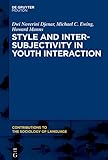Style and intersubjectivity in youth interaction / Dwi Noverini Djenar, Michael C. Ewing, Howard Manns.
Material type: TextSeries: Contributions to the sociology of language ; 108.Publisher: Boston : De Gruyter Mouton, [2018]Copyright date: ©2018Description: 1 online resource (xi, 255 pages) : illustrationsContent type:
TextSeries: Contributions to the sociology of language ; 108.Publisher: Boston : De Gruyter Mouton, [2018]Copyright date: ©2018Description: 1 online resource (xi, 255 pages) : illustrationsContent type: - text
- computer
- online resource
- 9781614516446
- 1614516448
- 9781501500701
- 1501500708
- 161451755X
- 9781614517559
- 9781614516439
- 161451643X
- Youth -- Language
- Interpersonal communication
- Indonesia -- Languages
- Sociolinguistics -- Indonesia
- POLITICAL SCIENCE -- Public Policy -- Cultural Policy
- SOCIAL SCIENCE -- Anthropology -- Cultural
- SOCIAL SCIENCE -- Popular Culture
- Indonesian language -- Social aspects
- Indonesian language -- Style
- Interpersonal relations
- Intersubjectivity
- Youth -- Language
- Youth -- Social life and customs
- Indonesia
- LANGUAGE ARTS & DISCIPLINES / Linguistics / General
- 306.44083/09598 23
Includes bibliographical references (pages 237-250) and index.
Online resource; title from PDF title page (accessed June 18, 2018).
Frontmatter -- Acknowledgments -- Contents -- List of Tables -- List of Figures -- Glosses -- Transcription Conventions -- Common Address Terms in the Data -- Common Discourse Particles in the Data -- 1. Style, intersubjectivity and youth sociability -- 2. Referring to self and other -- 3. Interactional particles and perspective management -- 4. Grammar as style -- 5. Presentation of voice in discourse -- 6. Youth and language play -- 7. Concluding remarks -- References -- Index.
This book examines how style and intersubjective meanings emerge through language use. It is innovative in theoretical scope and empirical focus. It brings together insights from discourse-functional linguistics, stylistics, and conversation analysis to understand how language resources are used to enact stances in intersubjective space. While there are numerous studies devoted to youth language, the focus has been mainly on face-to-face interaction. Other types of youth interaction, particularly in mediated forms, have received little attention. This book draws on data from four different text types - conversation, e-forums, comics, and teen fiction - to highlight the multidirectional nature of style construction. Indonesia provides a rich context for the study of style and intersubjectivity among youth. In constructing style, Indonesian urban youth have been moving away from conventions which emphasized hierarchy and uniformity toward new ways of connecting in intersubjective space. This book analyzes how these new ways are realized in different text types. This book makes a valuable addition to sociolinguistic literature on youth and language and an essential reading for those interested in Austronesian sociolinguistics.
In English.
This work is licensed under a Creative Commons license
https://creativecommons.org/licenses/by-nc-nd/4.0/legalcode
Master record variable field(s) change: 072

There are no comments on this title.